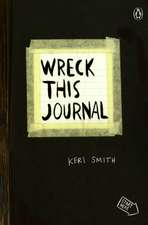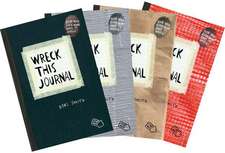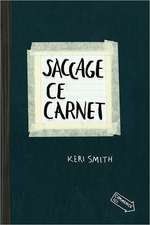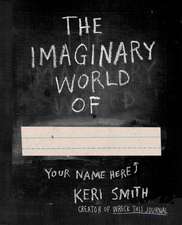The Artist Inside: A Spiritual Guide to Cultivating Your Creative Self
Autor Tom Crocketten Limba Engleză Paperback – 29 feb 2000
Getting inspired is one of the toughest parts of being an artist, whether we're a beginner or a seasoned professional. But as Tom Crockett shows us in this new book, finding ideas for our artwork is easier than we think. By simply exploring the images of our sleeping and waking dream states, we can discover a wealth of ideas and inspiration that are more authentic and powerful because they reveal our underlying spiritual self.
Recognizing the importance of allowing our spiritual side to infuse our art and the fulfillment this can bring, Tom Crockett has created a program to teach us all, no matter what level of artistic experience we have, how to bring art and spirit into one. The four different types of creative expression Crockett has identified--Finding, Arranging, Altering, and Making--open up artistic options for everyone, even for those of us who cannot yet imagine that we have the ability to create art. Filled with personal anecdotes from the author's creativity workshops and practical, easy-to-implement advice for tapping into our hidden creativity, The Artist Inside teaches us:
how to access the dreaming world to heighten creativity
that we can create in each piece of artwork a temporary home for the spirit
how creating a spiritual path can energize us and increase our intuitive capacity
When the process of making art is guided by the inner vision of our sleeping and waking dream states, we connect with something larger than ourselves and rediscover that creativity can be both a spiritual path and an important life tool.
Preț: 114.50 lei
Nou
21.91€ • 23.87$ • 18.46£
Carte disponibilă
Livrare economică 02-16 aprilie
Specificații
ISBN-10: 0767903943
Pagini: 272
Dimensiuni: 151 x 231 x 17 mm
Greutate: 0.4 kg
Editura: BROADWAY BOOKS
Extras
The artist and the shaman were probably one in the same, as artists have ever since claimed. Through their magical power to recreate the animals on the walls of the temple caves, they--the artist-shamans--connected the tribe with the source of life that animated both human and animal, becoming themselves vehicles of that source, creators of the living form like the source itself.
--Anne Baring and Jules Cashford, The Myth of the Goddess: Evolution of an Image
When was the last time you made music? When did you last dance? What was the last story you told? When was the last time you engaged in the "work" of art?
These are the questions a shaman or indigenous healer might ask if you came seeking help or guidance. It wouldn't matter whether your condition was physical, emotional, spiritual, or emotional. The answers to these questions would still be of vital interest. If your answer to any of these questions is "not within the past six months," you might be instructed to go home and sing, dance, perform, or express your creative spirit. This recommendation alone is often considered sufficient to cure an illness. But even if a return visit to the healer is required, this first step of entering into communion with the spirit world through creative expression is critically important.
There is a connection between artistic expression and spirit that resides deep in our ancestral memory. The native and indigenous cultures from which we all descend understand this connection. It is only our contemporary, Western view of art that de-emphasizes the connection between the material and the spirit. In his book, The Strong Eye of Shamanism: A Journey Into the Caves of Consciousness, Robert E. Ryan describes how a well-known aboriginal "shamanic ecstatic dream artist" named Allan Balbungu was able to separate his soul from his body, and, with the aid of his spirit helpers, enter the otherworld of the ancestors to find songs and dances for the tribe. "Allan translates his visionary experience onto the corroboree ground. The poet has delved deeply into the creative source, the world of the spirit, and touched its deepest source. This art not only represents his reception of the songs and dances he has received in the Otherworld but also the very structure of the creative visionary experience itself."
For tribal peoples, the "work" of art is the manifestation of spirit in material form. The tribal individual engaging in artistic expression first accesses the realm of spirit, seeking what we might call inspiration or the breath of the divine. This divine inspiration is then translated into material form with words, images, music, dance, or artifacts. Engaging the spirit, now in material form, through ritual completes the cycle. This ritual releases that spirit and draws artist and community alike back into sacred communion with the divine. This is the sacred creative cycle. It is a cycle of transformation. In his book, Voices of the First Day: Awakening in the Aboriginal Dreamtime, Robert Lawlor writes, "Sacred art always implies transformation: the transformation of pure energy into form, the transformation of ancestral powers into animals, animals into humans, and humans, through ritual costume and body painting, into the ancestral beings and their animal powers." When art is about transformation, it is a sacred practice.
But we needn't look far afield to find examples of artists engaging this sacred creative cycle. When dream artist Dan Raven finds a piece of stone, he studies it energetically, vision-shifting to look and listen to what the stone has to share. He slips momentarily into divine space to seek the animal spirit waiting to be released from the stone. Carving the stone is a careful process. He carves until just enough of the animal is visible. This is what is required to release the spirit into the world. More than this and he would be imposing form rather than revealing it. His carvings then become ritual offerings to the elements and power connections between the people who purchase them and the primal spirit. Dan hasn't done this work all his life. He just reached a point where he couldn't "not do it" any longer.
So why is this important? Most of us don't consider ourselves artists. Even if we secretly enjoy expressing ourselves creatively, we may still be frightened of claiming that we are artists. It may seem pretentious to label oneself as an artist, and identifying oneself as an artist might mean being judged. We remember how competitive the arts were in school. Someone else's work was always better than our own. Who needs that pressure?
The point is that being an artist, expressing oneself artistically, is a birthright, not a career path. It's part of what makes us whole and fulfilled. It's one of the primary ways we can connect with spirit in our lives.
The complaints that are most often expressed by members of Western, materialist cultures include a vague sense of unease and insecurity, a deep loneliness or emptiness, and, despite material abundance and prosperity, a sense of being unfulfilled. Sometimes our emotional and spiritual states of dis-ease end up manifesting in physical form within our bodies. But even emotional and spiritual distress can keep us from living our lives fully. A shaman or indigenous healer would identify our condition as growing from a lack of connection to community and spirit.
Engaging in the soulful expression of spirit through art is a way each of us can reconnect to spirit and find a place in a greater community. Organized religions can provide a connection to community and spirit, but many of us are simultaneously evolving beyond the need for institutions and authority figures that interpret the divine for us. We want direct experience. We no longer want to believe in a thing, we want to know it.
In the same way that we've come to rely upon gurus, spiritual leaders, and churches to experience the divine for us, we've also abrogated our right to engage in the "work" of art. We allow artists to make our art for us, as though it was nothing more than a craft or trade--a commodity to be produced by the most efficient means possible. This is as deadening to our creative soul as our reliance on organized religion has been to our spirit. This is not to suggest that powerful artists who dedicate a greater portion of their energy to manifesting spirit in material form will not bring us important visions through their work. In a small ideal community, we might have regular intimate contact with several individuals who engage in the work of art on behalf of their community. We would benefit immensely from such an arrangement, but our role would then be to reflect upon that vision in our lives, to manifest it and translate it through our own creative processes. There is no way around our own individual obligation and responsibility to honor spirit through creative expression.
Textul de pe ultima copertă
Getting inspired is one of the toughest parts of being an artist, whether we're a beginner or a seasoned professional. But as Tom Crockett shows us in this new book, finding ideas for our artwork is easier than we think. By simply exploring the images of our sleeping and waking dream states, we can discover a wealth of ideas and inspiration that are more authentic and powerful because they reveal our underlying spiritual self.
Having recognized the importance and fulfillment that comes from allowing our spiritual side to infuse our art, Tom Crockett has created a program to teach us, no matter what level of artistic experience, how to bring art and spirit into one. The four different types of creative expression Crockett has identified -- Finding, Arranging, Altering, and Making -- open up artistic options for everyone, even for those of us who cannot yet imagine that we have the ability to create art. Full of personal anecdotes from the author's creativity workshops and practical, easy-to-implement advice for tapping in to our hidden creativity, The Artist Inside teaches us:
how to access the dreaming world to heighten creativity that we can create in each piece of artwork a temporary home for spirit how creating a spiritual path can energize us and increase our intuitive capacity
When the process of making art is guided by the inner vision of our sleeping and waking dream states, we connect with something larger than ourself and rediscover that creativity can be both a spiritual path and an important life tool.










